9 Summer Dangers for Dogs Every Pet Owner Must Know Before It’s Too Late
When you purchase through links on our site, we may earn a commission. Here’s how it works.
It only takes 10 minutes in a hot car for a dog to lose consciousness. And that’s just one of the summer dangers for dogs that catch pet owners off guard.
Table of Contents
When the weather heats up, so do the risks, from heat stroke and runaway pups to itchy allergies and skin infections. Many of these issues peak in summer, but few dog parents realize just how fast they can strike… or how expensive they can get.

Summer fun can quickly turn perilous for your furry friend. The warm months pose unique threats to your dog’s health, from scorching heatwaves to hidden backyard hazards. Are you prepared to protect your pup from these seasonal dangers? Dive into our comprehensive guide to ensure your canine companion stays safe and happy all summer long.
We dug into the top Google searches, real pet insurance claims, and expert insights to uncover the most common summer emergencies for dogs and how to stop them before they start.
Why Summer Puts Dogs at Greater Risk: Understanding Summer Dangers for Dogs
Summer brings long walks, road trips, and backyard fun, but the warmer months also mean higher exposure to heat, parasites, allergens, and environmental hazards for dogs. Dogs can’t sweat the way humans do. They cool themselves primarily through panting and their paw pads, which makes them more vulnerable to overheating and dehydration.
Add to that the increased time spent outdoors, unpredictable weather patterns, and heightened activity levels, and you’ve got a perfect storm for health complications, many of which can escalate quickly if not caught early.
Summer means fun for you and your pup, but it also introduces real risks. Understanding the most common summer dangers for dogs can help prevent emergencies.
1. Heat Stroke: The #1 Summer Danger for Dogs
On a warm day, your dog doesn’t just feel hot. They’re at real risk of overheating. Heat stroke is one of the most common and deadly summer dangers for dogs. And it can happen faster than you think.
Heat stroke (or heat exhaustion) occurs when your dog’s body temperature climbs too high and can’t cool itself down. Dogs rely on panting to regulate heat, but once their internal temperature hits 105°F, panting alone isn’t enough. At that point, their body starts to shut down.
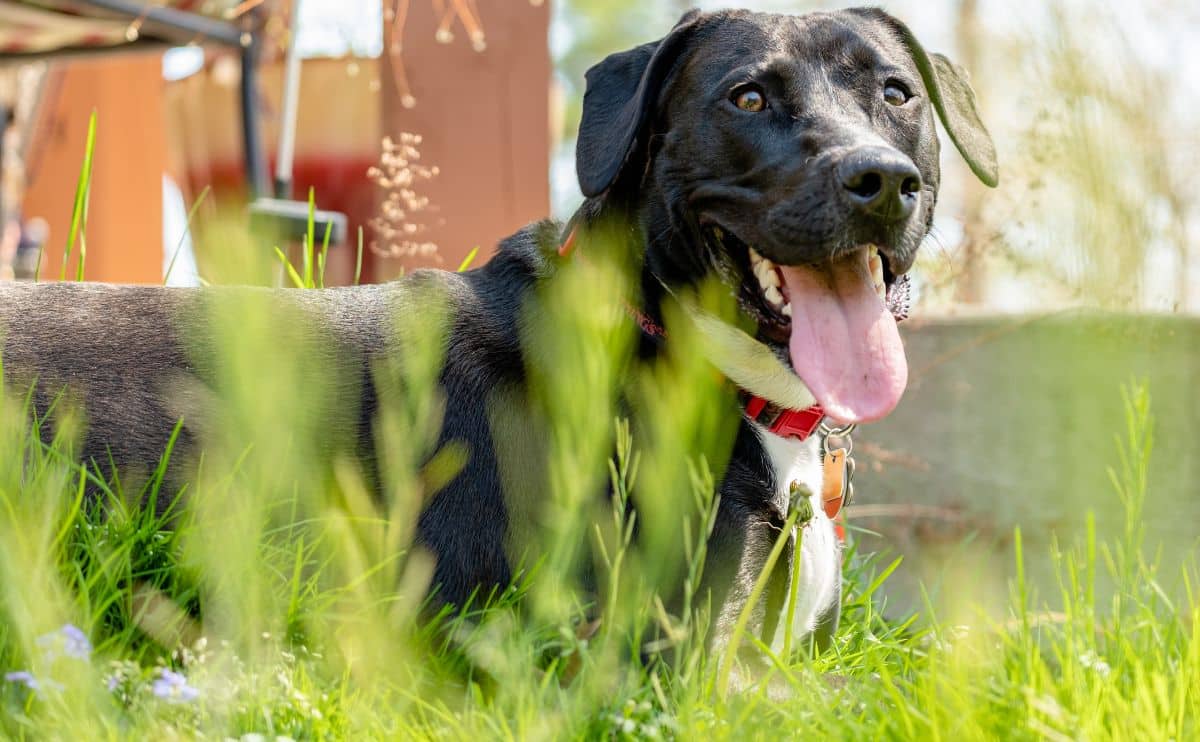
Understandably, heat strokes are more common when the temperatures are higher. Heat strokes or heat exhaustion can stem from an animal getting too hot, which can lead to symptoms such as dizziness, difficulty breathing, and potentially even death if the condition goes untreated.
Even mild outdoor temperatures can be dangerous. If it’s 75°F outside, the temperature inside a parked car can soar to 118°F in minutes. That’s more than enough to cause organ damage or worse.
Heat stroke is the most commonly experienced summer canine injury, with Google Trends data suggesting the search for advice on the condition begins as early as May when the climate begins to heat up.
While the average monthly searches for ‘heat stroke dog’ is 9,900, this term increases in May (14,800) and June (33,100) before peaking in July (40,500) – right in the middle of the warm summer season.
‘Signs of heat stroke in dogs’ (18,100) and ‘dog heat stroke symptoms’ (14,800) are also two incredibly prevalent search terms in July as owners look to identify the telltale symptoms of this dangerous condition.
Notable Data: In 2024, there were 111 reported heat-related animal deaths and 388 rescues due to heat exposure, according to PETA.
When analyzing regional search term data from Google Trends, the top three states searching the most for heat strokes in dogs were Oklahoma, Louisiana, and Mississippi. This makes sense when you consider that each of these three locations ranks inside the top ten warmest U.S. states, according to Current Results.
Know the Warning Signs of Heat Stroke in Dogs
With heat stroke proving a potentially fatal risk, it’s important for owners to understand what to look out for. Excessive panting is one of the most common signs that a pet could be suffering from the drastic effects of heat stroke.
Heat stroke symptoms can look different from dog to dog, but the most common ones include:
- Heavy panting or drooling
- Glazed eyes or confusion
- Vomiting or diarrhea
- Weakness or collapse
- Curled-up, unresponsive behavior
These signs mean your dog is in serious trouble. Immediate cooling and emergency care are critical.
5 Tips: What to Do (and What Not to Do)
- Never leave your dog in a car. Not for five minutes. Not with the windows cracked.
- Make sure your dog has access to clean water all day. If you’re outside, bring water with you.
- Avoid long walks or runs during peak heat. Stick to early morning or evening.
- Provide shade, cool surfaces, and regular breaks. Watch for panting that seems excessive or strained.
- If you think your dog is overheating, move them to a cooler area right away. Offer water and pour cool (not icy) water over their back and paws. Call your vet and head in immediately.
The dangers of heat stroke should never be underestimated. If you are concerned your dog may be suffering, we recommend seeking immediate veterinary attention. Vets can provide treatment such as oxygen therapy and intravenous (IV) drip and will be able to constantly monitor body temperature levels.

Dogs + Hot Cars = Deadly Mistake
- Cracking the windows doesn’t help.
- Parking in the shade isn’t enough.
- Leaving the A/C running can fail.
In just 10 minutes, the inside of a car can reach 118°F, even when it’s only 75°F outside. Dogs left in hot cars can suffer brain damage, organ failure, or death, often in under 30 minutes.

Reminder: Never leave your dog in the car. Not for a minute. Not ever.
The Cost of Waiting
Heat stroke can be fatal. Even if your dog survives, the treatment is intense and expensive.
Here’s what emergency care can look like:
- Emergency vet visit: $180 to $800
- IV fluids: $60 to $220
- Blood tests: $130
- Oxygen therapy: $100 or more
- Hospitalization: $60 to $600 per day
After your dog is treated and recovered from heat stroke, you could face a vet bill exceeding $1,000. Without pet insurance, you’re responsible for the expense of treatment alone. However, insuring your pet may make your dog eligible for coverage, meaning you don’t have to shoulder the financial burden alone.
Our Perfect Day Almost Turned Tragic: A Scary Lesson in Summer Heat for Dog Owners
We all think it won’t happen to our dog… until it almost does. Here’s what one of our team members experienced on a routine summer hike with her pup.

It started out as one of those perfect summer days—the kind that makes you want to stay outside forever. I had taken Falkor, my curly little Poodle Beagle mix, up into the mountains for a hike and some fresh air therapy. He was in his element: nose to the ground, tail wagging, chasing minnows in the shallows, and practically grinning during our picnic by the lake.
What was a great day turned scary quickly when Falkor started acting strangely. First, he started panting, then threw up a little and curled up in a ball at my feet.
I offered him water. He took a few half-hearted sips but didn’t perk up. That’s when it hit me, he was overheating.
Falkor has a thick, fluffy coat that traps heat, and I’d let him push too far in the afternoon sun. I scooped him up, found a shady patch off-trail, and poured cool water over his back, gently working it through all that hair until it reached his skin. I fanned his face and whispered all the silly pet-parent things we say when we’re scared: “You’re okay, buddy. I’ve got you.”
After a few minutes, he started to come around. His eyes got brighter, he drank a little more, and that spark I know so well flickered back. I carried him the rest of the way down, packed him into the car, and drove straight to the vet.
By the time we got there, he was his happy self again; some cold AC and tasty treats helped a lot, too. He bounced back just fine, and these days, I’m even more prepared to help him stay cool and comfortable when the temperatures climb.
– Danielle DeGroot, Rescue Dog Mom & Canine Journal Writer
2. Lost Dogs: The Summer Danger That Breaks Hearts
Summer is the season of open doors, road trips, and backyard BBQs. It’s also the time of year when more dogs go missing.
According to Petco Love Lost, 1 in 3 pets will get lost at some point in their lives. Even worse? Only 1 in 5 dogs will make it back home on their own.

That’s heartbreaking. And preventable.
Warm weather means more outdoor activities, distractions, travel, and chances for your dog to slip away in the excitement. The spike in lost dogs is so prevalent it shows up in search data.
The generic search term ‘lost dog’ remains prevalent across the entire year, seeing average monthly searches of 22,200 in 11 of the 12 months of the year (including each of the summer months).
But in July, more desperate terms start to peak:
- “Lost dogs near me” – 12,100
- “Missing dog near me” – 5,400
- “Missing dog” – 5,400
Every summer, these searches surge. It’s one of the most overlooked summer dangers for dogs.
4 Tips to Keep Your Dog Safe & Home
Don’t wait for a close call. These tips can help keep your dog exactly where they belong at home with you.
1. Microchip Your Dog
A microchip under the skin means shelters and vets can scan for your info, even if your dog loses their collar.
2. Use a Secure ID Tag
Collars and tags with updated contact info can be a lifesaver. For extra peace of mind, consider a QR code tag that links to your number or vet.
3. Check Your Fencing
Give your yard a safety audit. Dogs can dig, squeeze, or leap their way out before you even notice they’re gone. You may want to consider an electric fence if you have a frequent escaper or a dog that can jump the fence.
4. Practice Basic Commands
A strong “come,” “stay,” or “leave it” can save your dog’s life, especially in high-distraction environments like campsites, trails, or public parks. Even older dogs can benefit from a basic training refresher.
Losing Daisy for a Day Was the Scariest and Most Important Thing That Happened That Summer
When one of our team members lost her dog after a fence escape, she didn’t expect the story to end with shade trees, kind strangers, and a life lesson.
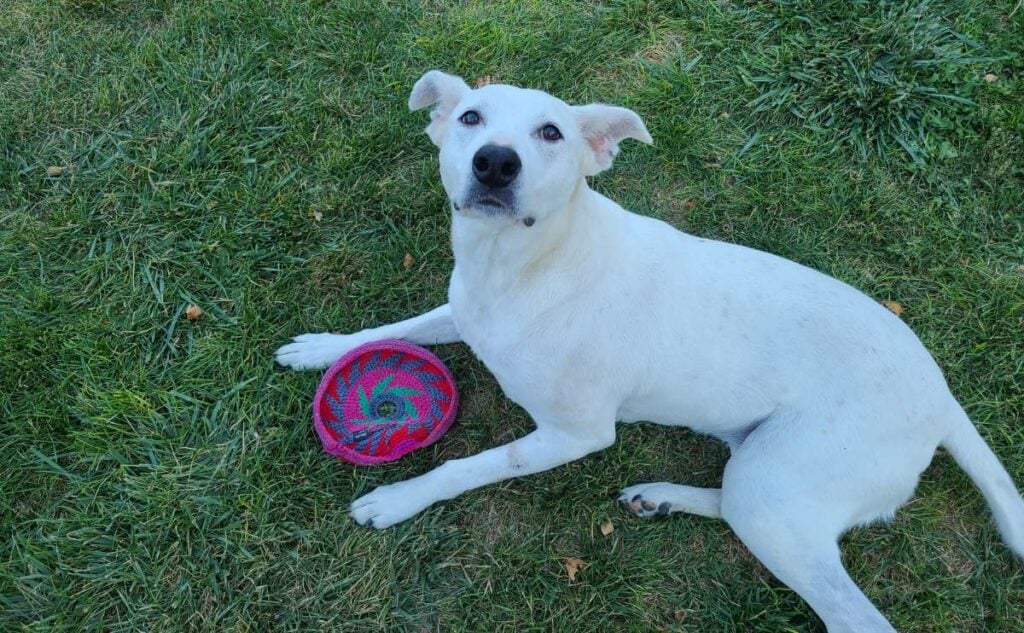
I’ll never forget the summer Daisy went rogue.
We had just moved into a new house with a huge backyard, and she was living her best life, zoomies, sunbathing, squirrel surveillance duty. Daisy is a Pitbull Lab mix with the muscles of a linebacker and the heart of a toddler in a thunderstorm. And like a toddler, she hates loud noises.
Cue the neighbor’s power tools.
I was inside, completely unaware that someone had fired up what I can only assume was a jet engine disguised as a leaf blower. The next thing I hear is a crash… and I run out just in time to catch a glimpse of Daisy’s back legs launching through a busted fence panel like she was competing in the Olympic steeplechase.
Gone. Full gallop. Fueled by fear and the sound of a weed whacker.
We searched for hours. I was sweaty, panicked, and picturing every worst-case scenario. Finally, we spotted her a few blocks over, lounging under a tree in someone’s yard like she was on a spa retreat. Thankfully, the people were dog lovers. They’d put out a bowl of water and let her chill like she owned the place.
That moment was a huge relief and a reminder.
Daisy was wearing her ID tags, and she’s microchipped too. I didn’t end up needing either that day, but just knowing that someone could’ve scanned her chip or read her collar gave me peace of mind.
Now, I double-check the gate every time I hear a lawn mower, and Daisy wears her collar like it’s part of the uniform. Because you never know what sound will send a dog into “nope” mode, and I never want to relive that heart attack again.
– Danielle DeGroot, Rescue Dog Mom & Canine Journal Writer
3. Ear Infections: Summer Moisture & Bacteria Risks
Long walks. Lake swims. Hours of fetch in the sun. Summer fun can lead to one seriously uncomfortable downside: ear infections.
Heat and moisture create the perfect breeding ground for bacteria. If your dog’s ears stay damp or dirty, especially if they have floppy ears or love the water, you’re looking at a much higher risk of infection. It may not be something we think of right away, but that moisture can turn into one of the top summer dangers for dogs.

5 Signs Your Dog Might Have an Ear Infection:
- Funky or sour ear odor
- Head shaking or tilting
- Loss of balance or coordination
- Yellow, brown, or bloody discharge
- Scratching like there’s no tomorrow
If any of that sounds familiar, call your vet. The sooner it’s treated, the better your dog will feel and the less likely it is to come back.
Ear infections are the third most common reason pet insurance claims are filed. Treatment typically costs $100–$250, and chronic cases aren’t unusual. That means some dogs may need treatment multiple times a year.
Pet Insurance Tip: The average claim payout for ear infections is around $40.82, but that increases as you meet your deductible. Coverage can add up in your favor if your dog is prone to ear trouble.
4. Paw Pad Burns: The Pain You Might Not See Coming
You know that dance your dog does on hot pavement? It’s not cute. It’s panic.
During summer, surfaces like asphalt, sand, and even the back of a truck bed can get hot enough to burn skin in seconds. And your dog’s paw pads? They’re tough but not heat-proof.
Google search data shows that interest in “dog paw pad burns” increased during peak summer months.
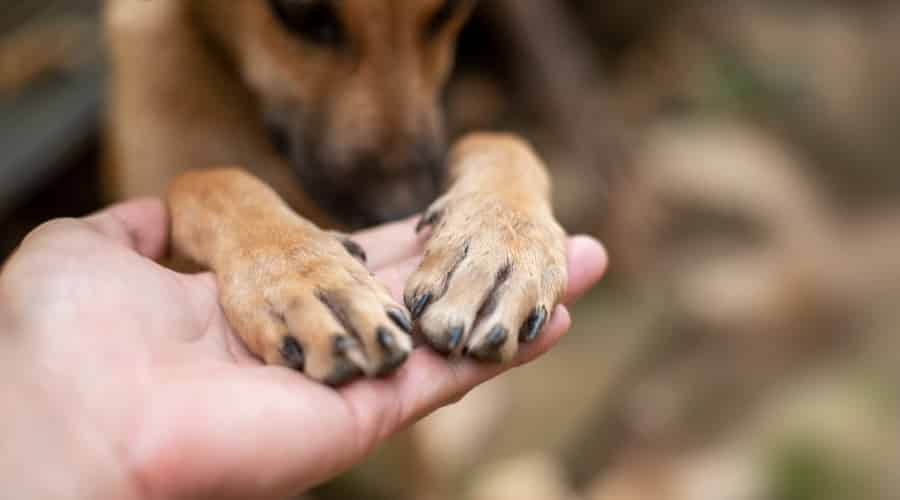
If it’s too hot for the back of your hand, it’s too hot for your dog’s paws.
How Hot Is Too Hot?
- At 85°F, asphalt can reach 130°F.
- At 95°F, it can spike to 150°F or more.
That’s enough to cause second-degree burns in under a minute.
Notable Data: Pavement temperatures can reach up to 125°F when the air temperature is 77°F, posing a risk for paw pad burns in dogs.
And the worst part? Most dogs won’t whine or stop walking. They’ll just keep going, burning their paws with every step.
Signs of Paw Pad Burns:
- Limping or refusing to walk
- Darkening or reddening of the pads
- Blisters or peeling skin
- Licking or chewing at their feet
If you notice any of these symptoms, bring your dog inside, rinse their paws with cool water, and call your vet.
How to Protect Their Paws:
- Walk early or late. Avoid midday walks when surfaces are hottest.
- Test the ground. Place the back of your hand on the pavement for 7 seconds. If it’s too hot for you, it’s too hot for them.
- Use dog booties. Yes, they might look silly, but they could save your dog from weeks of pain.
- Apply paw balm. It adds a layer of protection and can help heal dry or cracked pads after outdoor time.
Summer pro tip: Try walking your dog on grass or dirt trails whenever possible. They’re cooler, gentler, and way easier on those paws.
75 Pounds of Dalmatian. One Mile of Hot Sand. No Booties. Never Again.
Here’s what happened when hot sand, a big dog, and no booties turned a simple hike into a hard lesson.

Several years ago, I was hiking in San Diego with my 75-pound Dalmatian on a sandy trail. With few trees to shade the path, the heat started burning his feet. I did not realize it until we stopped at a pond, and he stood the whole time in the shallow water.
When he refused to move any further, I was glad to have a friend along to help me carry him back to the car the last 1/3 of a mile. After that, I got him booties to protect his paws on these hot hikes.
– Michelle Schenker, Rescue Dog Mom & Canine Journal Co-Founder
5. Dehydration: The Silent Summer Threat
Dogs can go from playful to parched in a flash. They lose moisture quickly in the heat through panting and the sweat glands in their paws, especially during long walks, hikes, or backyard play sessions.
Unlike people, dogs can’t tell you when they’re thirsty. And by the time signs show up, dehydration may already be setting in. This is one of the most serious summer dangers for dogs.
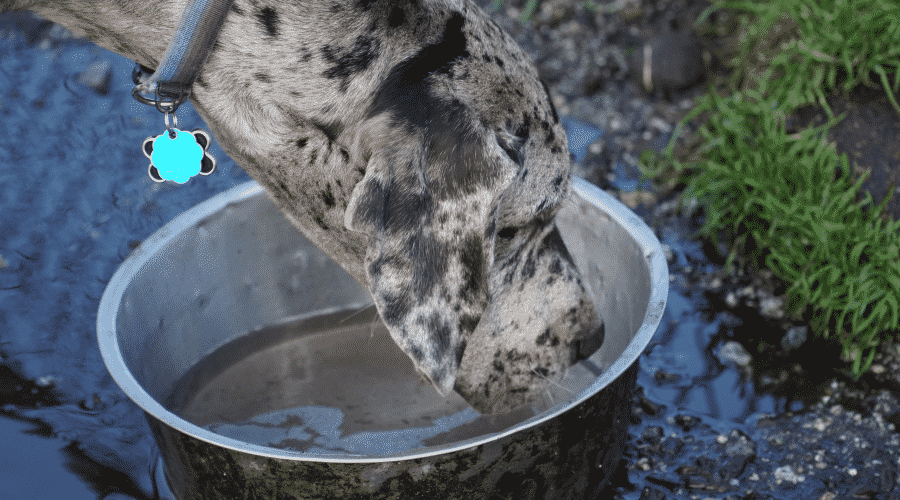
4 Early Warning Signs of Dehydration in Dogs:
- Dry or sticky gums instead of moist, pink ones
- Sunken eyes or a tired, hollow look
- Lethargy or sluggishness, especially after exercise
- Loss of skin elasticity (a gentle pinch of skin at the shoulders doesn’t bounce back normally)
Severe dehydration can lead to heat exhaustion, kidney damage, and even death if left untreated.
How to Keep Your Dog Hydrated:
- Keep water available at all times—indoors, outdoors, and on the go
- Carry a portable water bottle or collapsible bowl during walks or car rides
- Toss in a few ice cubes on especially hot days—some dogs love the crunch
- Avoid intense play or exercise during peak sun hours
- Watch for signs of overheating, like heavy panting or glazed eyes
When in doubt, offer water, find shade, and let your dog rest. Dehydration can creep in quickly, but a little preparation goes a long way in keeping your pup safe.
Pro tip: Add a splash of low-sodium bone broth or pet-safe electrolyte solution to encourage drinking if your dog seems uninterested in plain water.
6. Hot Spots: Summer’s Sneakiest Skin Nightmare
Ever notice your dog obsessively licking one spot, then suddenly, there’s a raw, red mess on their skin? That’s a hot spot.
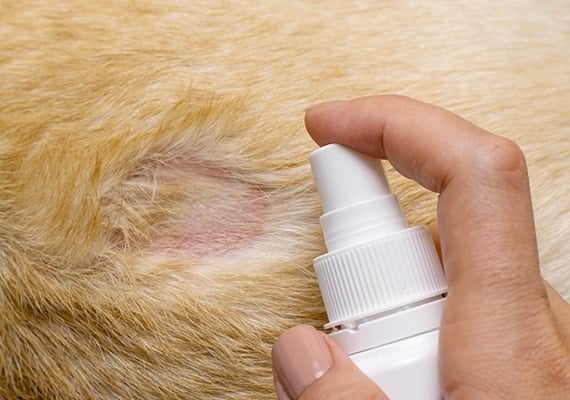
Hot spots (aka acute moist dermatitis) often appear in summer, especially in humid areas. They can be triggered by:
- Flea bites or insect stings
- Allergic reactions
- Poor grooming or a matted coat
- Minor skin injuries
- Even stress or boredom licking
What starts as a small itch can quickly turn into a painful infection if left alone.
What to Look For:
- Red, oozing patches of skin
- Swelling and hair loss around the area
- Constant licking, chewing, or biting
- Sensitivity when you touch the spot
Treatment usually involves cleaning the area with an antiseptic solution and keeping your dog from licking it (hello, cone of shame). In some cases, antibiotics or further testing may be needed, especially if allergies are to blame.
Treating hot spots costs anywhere from $100 to $200, but more complex cases can skyrocket to $1,000 or even $2,000 if allergy testing or diagnostics are needed.
Pet Insurance Tip: Skin irritations like hot spots are the 6th most common dog insurance claim. Coverage helps reduce out-of-pocket surprises, especially if flare-ups are frequent.
7. Seasonal Allergies in Dogs: When Pollen Ruins Playtime
You’re not the only one sneezing through summer. Dogs can suffer from seasonal allergies, too, and they don’t just sniffle; they scratch, lick, and chew themselves raw.
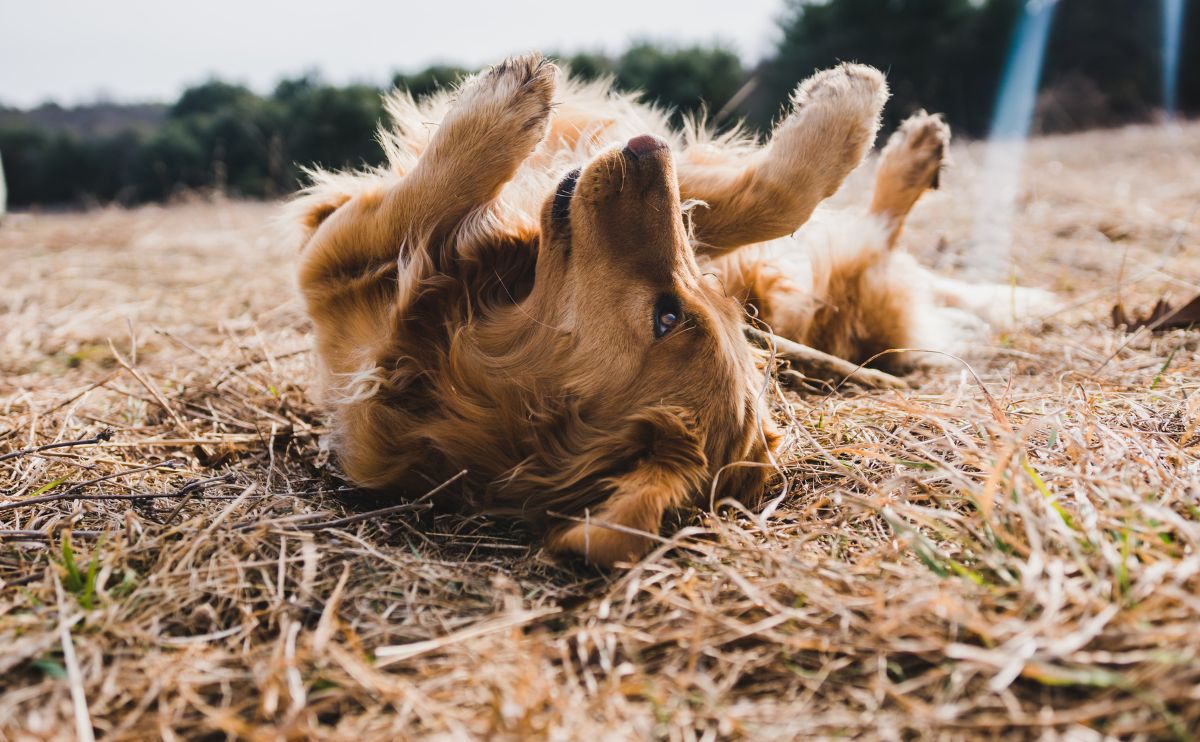
As insects, grasses, and pollen bloom, so does your dog’s sensitivity to them. This is one of the sneakiest summer dangers for dogs, especially those with existing skin or immune issues.
5 Common Symptoms of Summer Allergies in Dogs:
- Itchy, red skin
- Excessive scratching or paw licking
- Rubbing their face or eyes on the carpet
- Ear infections or recurring hot spots
- Hair thinning or bald patches
Some owners think their dogs are just itchy from the heat. But constant irritation with no relief? That’s a sign of an allergy flare-up.
At-home allergy test kits can help uncover triggers, and your vet can suggest antihistamines, prescription meds, or even allergy shots.
The costs can vary:
- Allergy testing: $200–$300
- Allergy shots: $600–$1,500/year
- Prescription meds: $65+/month
Pet Insurance Tip: Allergies are one of the top 5 most claimed conditions. If your dog’s symptoms persist every summer, insurance can help cover long-term treatment.
8. Sunburn in Dogs: Risks, Symptoms & Protection
Many of us humans are steadfast in our commitment to sun protection, but that doesn’t always extend to our furry friends.

Just like humans, dogs can suffer from sunburn, especially those with light-colored coats, thin fur, or exposed skin. But in dogs, sunburn isn’t just uncomfortable. It can lead to painful blistering, skin infections, long-term damage, and even skin cancer, such as hemangiosarcoma or squamous cell carcinoma.
At-Risk Breeds
Breeds most vulnerable to sunburn include:
- Pit Bulls and other short-haired dogs
- Dalmatians with thin, light-colored coats
- Greyhounds and Whippets with minimal fur
- Boxers, Bulldogs, and Bull Terriers due to skin exposure
Dogs that have been shaved (for surgery or grooming) are also at increased risk, as their natural UV protection is reduced.
Symptoms of Sunburn in Dogs
- Red, inflamed skin (especially on the nose, ears, belly, or groin)
- Whining or flinching when touched
- Dry, cracked skin or scabbing
- Blisters or peeling in severe cases
- Behavioral changes such as licking the affected areas or seeking shade
If left untreated, sunburn can lead to secondary skin infections and long-term cellular damage.
4 Sunburn Prevention Tips For Dogs
- Use Dog-Safe Sunscreen: Choose a product specifically made for dogs. Never use sunscreen with zinc oxide or PABA, as these are toxic to pets if ingested. Focus on sensitive areas like the nose, ear tips, belly, and groin. One example: Vet’s Best Sun Relief Spray
- Avoid Midday Sun: Restrict outdoor activity between 10 AM and 4 PM when UV levels are at their peak.
- Provide Adequate Shade: Whether it’s an umbrella, tree cover, or a portable canopy, shaded areas reduce risk significantly.
- Consider Protective Clothing: Lightweight, UV-blocking shirts or hats designed for dogs can offer physical protection for vulnerable areas.
What to Do If Your Dog Gets Sunburned
- Move your dog to a cool, shaded, or indoor space immediately.
- Gently apply a cool (not ice-cold) compress to the affected area to reduce discomfort.
- Use a pet-safe aloe vera gel or soothing skin balm to reduce inflammation.
- Prevent licking of the affected area, which can cause further irritation or infection.
- Contact your veterinarian if blistering, oozing, or excessive peeling occurs.
Important: Do not apply human-grade sunburn products containing lidocaine, hydrocortisone, or other medicated ingredients unless your vet approves.
9. Fleas and Ticks in Summer: Parasite Prevention, Symptoms, and Treatment
Warm, humid summer months create the perfect breeding ground for parasites like fleas and ticks. These pests don’t just cause itching and irritation—they can transmit serious diseases to dogs and humans alike, including Lyme disease, ehrlichiosis, anaplasmosis, and tapeworms.
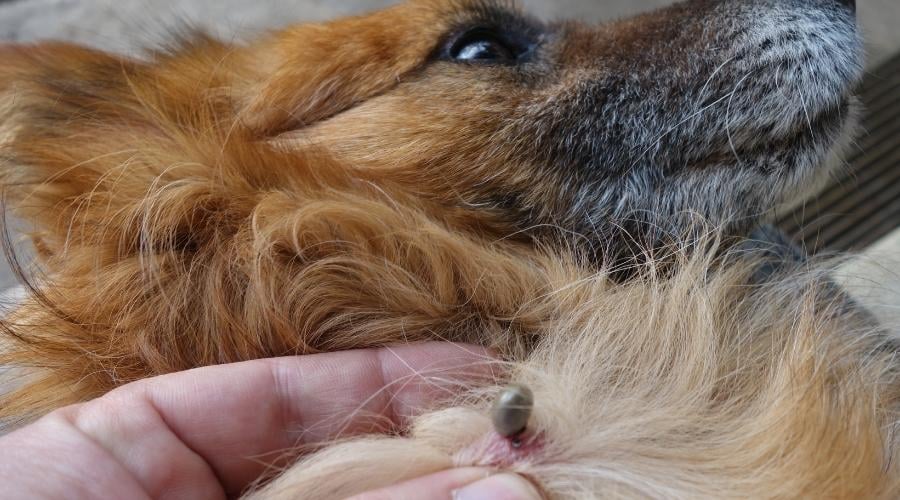
Why Fleas and Ticks Are Worse in Summer
Fleas and ticks thrive in temperatures between 70–85°F and in areas with high humidity. They are often found in:
- Tall grasses, leaf litter, and wooded areas
- Dog parks or yards with untreated soil
- Indoor spaces with carpet, furniture, and bedding once they hitch a ride inside
- Dogs are most at risk during walks, hikes, and outdoor playtime in the summer.
Search Trends: “Dog flea and tick prevention” saw heightened search activity during warmer months.
Notable Data: The 2025 forecast indicated a growing risk of vector-borne diseases in dogs, emphasizing the need for preventive measures, according to data from the Companion Animal Parasite Council (CAPC).
Common Symptoms of Flea or Tick Infestation
Fleas
- Frequent scratching, biting, or licking, especially near the tail and back legs
- Red bumps or scabs on the skin
- Flea dirt (black specks) in the coat or bedding
- Hair loss or hot spots in severe infestations
Ticks
- A visible tick attached to the skin, often behind the ears, under the legs, or around the neck
- Local swelling or redness around the bite site
- Lethargy, joint pain, or fever in cases of tick-borne illness
- Pale gums or loss of appetite in severe cases
4 Flea and Tick Preventive Measures
- Use Year-Round Preventatives: Veterinary-recommended flea and tick preventatives come in various forms, including monthly topicals (like Frontline or Advantage), oral chewables (such as NexGard or Simparica), or long-lasting collars (like Seresto). Always follow dosage based on weight and age, and consult your vet before starting any new product.
- Regular Grooming and Inspections: Check your dog’s coat and skin daily during summer, especially after outdoor activity. Use a flea comb to catch early infestations.
- Yard and Home Maintenance: Keep grass trimmed and remove leaf litter. Treat outdoor areas with pet-safe insecticides if infestations are common. Wash pet bedding and vacuum carpets regularly to eliminate eggs and larvae.
- Avoid High-Risk Areas: If ticks are prevalent in your region, avoid tall grasses, wooded trails, or stagnant water sources unless your dog is well protected.
What to Do If You Find a Flea or Tick
Ticks:
- Use fine-tipped tweezers to grasp the tick as close to the skin as possible.
- Pull upward with steady, even pressure—do not twist or jerk.
- Clean the area with antiseptic and monitor for swelling or signs of infection.
- Save the tick in a sealed bag in case testing is needed.
Fleas:
- Bathe your dog with a veterinarian-approved flea shampoo.
- Follow up with a flea comb and thoroughly clean bedding and living areas.
- Begin a monthly flea control regimen to prevent recurrence.
3 More Sneaky Summer Dangers for Dog Owners Often Miss
Not every summer danger comes with obvious signs like heavy panting or collapsed pups. Some risks creep up quietly, and Google search trends show that more dog owners are looking for answers when it’s almost too late.
1. Mosquitoes and Heartworm
Heartworms may not be visible, but they are deadly and spread. One mosquito bite can transmit this parasite, invading the heart and lungs.
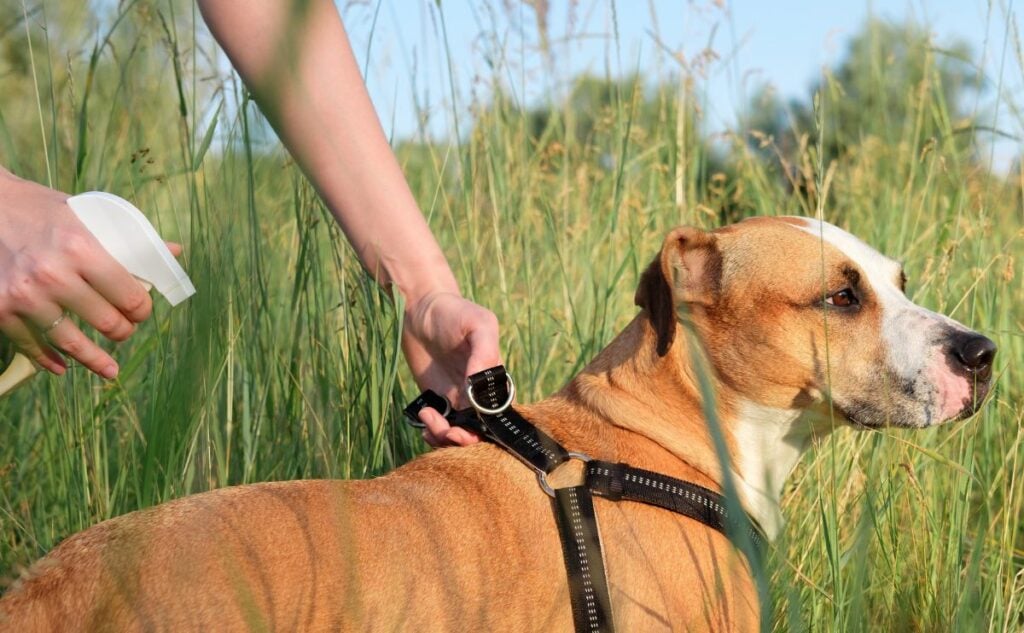
Monthly preventatives are essential, especially in humid regions where mosquitoes thrive.
Notable Data: The Companion Animal Parasite Council’s 2025 forecast highlighted an expanding risk of Lyme disease, heartworm, anaplasmosis, and ehrlichiosis in dogs.
2. Grass Seed Injuries
They’re small, sharp, and sneaky. Grass seeds (or awns) are often embedded in your dog’s skin, ears, or paws, leading to swelling, infection, and sometimes surgery.
Notable Data: A veterinary study by the University of Liverpool in 2021 found that 90.6% of grass seed foreign body cases in dogs occurred between June and September, with the highest incidence in July.
3. Digestive Disasters
Dogs have an unfortunate talent for eating things they shouldn’t, especially in summer. From spoiled food and beach snacks to bones, sticks, and even sand, the risk of vomiting or diarrhea skyrockets this time of year.

Search Trends: “Dog diarrhea” and related terms saw consistent search interest throughout the year, with slight increases during the summer months.
Summer Safety Checklist: Preventing Common Summer Dangers for Dogs
Explore our checklist to avoid common summer dangers for dogs this season.
Before You Head Outside
- Check the temperature (avoid walks during midday heat)
- Pack fresh water and a portable bowl
- Apply dog-safe sunscreen (especially for light-coated dogs)
- Apply flea and tick preventative
- Confirm ID tags and microchip info are current
- Check the ground temperature with the back of your hand
- Choose shaded paths or grassy areas for walking
During Outdoor Activities
- Offer water breaks every 15–20 minutes
- Monitor for signs of heat exhaustion (excessive panting, drooling, or lethargy)
- Keep play sessions short in hot weather
- Avoid letting your dog drink from ponds or standing water
- Provide access to shade or cooling mats
After Time Outside
- Check for ticks, burrs, or paw injuries
- Rinse off chlorine, salt, or grass allergens
- Rehydrate with cool, clean water
- Monitor for signs of sunburn, hot spots, or insect bites
- Wash toys, collars, and leashes regularly
While there is a heightened risk of potential doggy health dangers during summertime, owners are advised to use their common sense while routinely checking their animals to ensure they’re in great health. Should there be any problems, we always advise seeking urgent veterinary advice.
Do you have any summer safety tips for dogs? We’d love to hear them in the comments. And you can check out our fun video below which shares some great summer activities for dogs.
Summer Fun With Your Dog: Safe, Healthy, and Memorable
Summer isn’t just a season. It’s an opportunity to build unforgettable memories with your dog. From hiking shady trails to splashing in safe swim zones, there are endless ways to enjoy the warmer months while keeping your dog safe and comfortable.
But safety must come first. Whether it’s avoiding heatstroke, checking for ticks, or using dog-safe sunscreen, your preparation makes the difference between a great day and an emergency visit.
Once you’ve got the safety checklist covered, it’s time for the fun part.
Looking for creative, safe, and enriching ways to enjoy summer with your pup? Explore our full list of dog-friendly adventures, games, and outdoor activities to keep your pup’s summer fun and safe. Make this summer your dog’s best one yet, safe, active, and full of tail-wagging joy.



